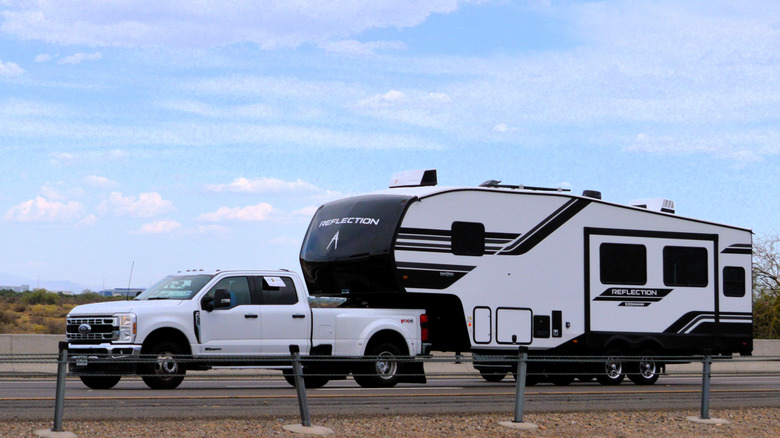Can A Pickup Truck Tow A Semi-Trailer?
Asking a lot of "what ifs" is what drives motor and truck enthusiasts to achieve extraordinary technological leaps that keep the industry moving forward. Little of that, however, is likely to come to mind when questioning if you can hitch a semi trailer to a pickup truck. Before wondering who on Earth would attempt this, could it even be done at all? And what would the result be, should someone manage it?
In short, yes, it can be done, though it goes without saying that it's a terrible idea, assuming the trailer is fully-loaded. Sure, some modified pickups boast greater horsepower than even large semis like the ubiquitous Kenworth W900, which only delivers around 500 to 600 horsepower. Consumer upgrades for Cummins engines can add loads of power for relatively little.
But that discounts the fundamental issues of physics at-play — it's not about how much raw power and torque the truck can exert. Yes, a pickup with sufficient power figures can move a trailer just fine under its own momentum, but that same element is at the heart of the problem. There's good reason why heavy-duty big rigs have multiple wheels, reduction gearboxes, massive air brakes, and so on. Let's explore how such a setup actually functions and what happens at a physics-level.
Pickups lack the heavy-duty gear needed to successfully support a semi trailer
A glaring issue is that pickups lack the traditional third-wheel utilized on tractor-trailers. Without that, how can a semi trailer hook up at all? One answer is to purchase a third-wheel kit, which are designed to operate within parameters like the weight of the trailer pressing down on the hitch, your truck's total weight limit, and so on. Selecting a suitably heavy-duty hitch and then grossly overloading the trailer is theoretically possible, though it won't solve how to hook up other trailer components such as the brakes.
Semi-truck trailers utilize air brakes that run off a compressor hooked to the engine. The lines you see running from the tractor to the trailer resembling coiled hoses are actually air lines connected to the truck's air brake system. A pneumatic system like this must maintain pressure or else the emergency brakes will engage. It's a safe and clean way to operate semi-truck trailers, though it's likely not compatible with pickups since no production model uses air brakes as standard. Thus, to operate a semi-truck trailer correctly, one would have to install an auxiliary compressor to power the brakes, then leave it open to allow the trailer to roll freely. Some trucks, like a Ford F550 Super Duty, do feature such a system, though these medium-duty trucks are commonly used for commercial and fleet use as opposed to light-duty passenger pickups.
The physics of large trailers on small trucks
Let's assume the worst-case scenario and imagine that someone puts a 40-foot shipping container on a gooseneck trailer with a load capacity of 38,000 to 40,000 pounds without a truck designed to haul such weight. As alluded to earlier, this is where the law of conservation of momentum comes into play, meaning an object that's in motion will stay in motion unless acted upon by an outside force. That outside force is normally a truck's brakes. But what happens when traveling at highway speeds and you have to suddenly slow down while carrying such a payload? This problem intensifies for trailers without functioning brakes, leaving the truck to do everything on its own.
Moreover, a pickup truck is far lighter than a semi. The weight difference can lead to substantial control issues. There's a reason why semi trucks are rear-wheel drive, have legal weight requirements, and use wide tires. These measures not only reduce ground pressure, but also increases the surface area the truck can use for stopping force in emergencies, which helps prevent tipping or shifting cargo around. None of these safeguards are present with a light-duty pickup. So yes, it can technically haul the goods – but the real question is, can it actually maintain control and stop safely? Most likely no.


